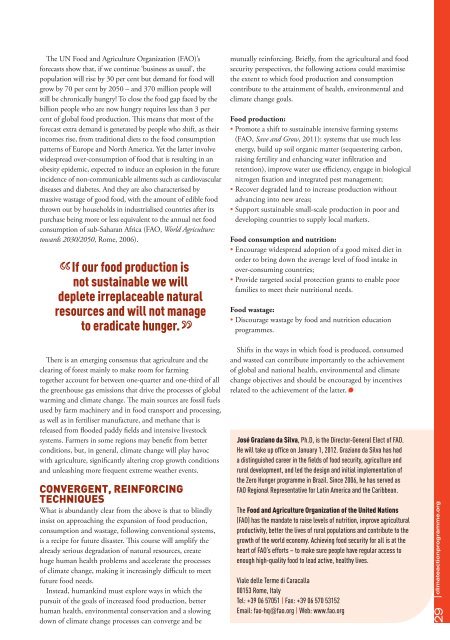Climate Action 2011-2012
Create successful ePaper yourself
Turn your PDF publications into a flip-book with our unique Google optimized e-Paper software.
The UN Food and Agriculture Organization (FAO)’s<br />
forecasts show that, if we continue ‘business as usual’, the<br />
population will rise by 30 per cent but demand for food will<br />
grow by 70 per cent by 2050 – and 370 million people will<br />
still be chronically hungry! To close the food gap faced by the<br />
billion people who are now hungry requires less than 3 per<br />
cent of global food production. This means that most of the<br />
forecast extra demand is generated by people who shift, as their<br />
incomes rise, from traditional diets to the food consumption<br />
patterns of Europe and North America. Yet the latter involve<br />
widespread over-consumption of food that is resulting in an<br />
obesity epidemic, expected to induce an explosion in the future<br />
incidence of non-communicable ailments such as cardiovascular<br />
diseases and diabetes. And they are also characterised by<br />
massive wastage of good food, with the amount of edible food<br />
thrown out by households in industrialised countries after its<br />
purchase being more or less equivalent to the annual net food<br />
consumption of sub-Saharan Africa (FAO, World Agriculture:<br />
towards 2030/2050, Rome, 2006).<br />
If our food production is<br />
not sustainable we will<br />
deplete irreplaceable natural<br />
resources and will not manage<br />
to eradicate hunger.<br />
mutually reinforcing. Briefly, from the agricultural and food<br />
security perspectives, the following actions could maximise<br />
the extent to which food production and consumption<br />
contribute to the attainment of health, environmental and<br />
climate change goals.<br />
Food production:<br />
• Promote a shift to sustainable intensive farming systems<br />
(FAO, Save and Grow, <strong>2011</strong>): systems that use much less<br />
energy, build up soil organic matter (sequestering carbon,<br />
raising fertility and enhancing water infiltration and<br />
retention), improve water use efficiency, engage in biological<br />
nitrogen fixation and integrated pest management;<br />
• Recover degraded land to increase production without<br />
advancing into new areas;<br />
• Support sustainable small-scale production in poor and<br />
developing countries to supply local markets.<br />
Food consumption and nutrition:<br />
• Encourage widespread adoption of a good mixed diet in<br />
order to bring down the average level of food intake in<br />
over-consuming countries;<br />
• Provide targeted social protection grants to enable poor<br />
families to meet their nutritional needs.<br />
Food wastage:<br />
• Discourage wastage by food and nutrition education<br />
programmes.<br />
There is an emerging consensus that agriculture and the<br />
clearing of forest mainly to make room for farming<br />
together account for between one-quarter and one-third of all<br />
the greenhouse gas emissions that drive the processes of global<br />
warming and climate change. The main sources are fossil fuels<br />
used by farm machinery and in food transport and processing,<br />
as well as in fertiliser manufacture, and methane that is<br />
released from flooded paddy fields and intensive livestock<br />
systems. Farmers in some regions may benefit from better<br />
conditions, but, in general, climate change will play havoc<br />
with agriculture, significantly altering crop growth conditions<br />
and unleashing more frequent extreme weather events.<br />
ConvergenT, reinForCing<br />
TeChniqueS<br />
What is abundantly clear from the above is that to blindly<br />
insist on approaching the expansion of food production,<br />
consumption and wastage, following conventional systems,<br />
is a recipe for future disaster. This course will amplify the<br />
already serious degradation of natural resources, create<br />
huge human health problems and accelerate the processes<br />
of climate change, making it increasingly difficult to meet<br />
future food needs.<br />
Instead, humankind must explore ways in which the<br />
pursuit of the goals of increased food production, better<br />
human health, environmental conservation and a slowing<br />
down of climate change processes can converge and be<br />
Shifts in the ways in which food is produced, consumed<br />
and wasted can contribute importantly to the achievement<br />
of global and national health, environmental and climate<br />
change objectives and should be encouraged by incentives<br />
related to the achievement of the latter.<br />
José Graziano da Silva, Ph.D, is the Director-General Elect of FAO.<br />
He will take up office on January 1, <strong>2012</strong>. Graziano da Silva has had<br />
a distinguished career in the fields of food security, agriculture and<br />
rural development, and led the design and initial implementation of<br />
the Zero Hunger programme in Brazil. Since 2006, he has served as<br />
FAO Regional Representative for Latin America and the Caribbean.<br />
The Food and Agriculture Organization of the United Nations<br />
(FAO) has the mandate to raise levels of nutrition, improve agricultural<br />
productivity, better the lives of rural populations and contribute to the<br />
growth of the world economy. Achieving food security for all is at the<br />
heart of FAO’s efforts – to make sure people have regular access to<br />
enough high-quality food to lead active, healthy lives.<br />
Viale delle Terme di Caracalla<br />
00153 Rome, Italy<br />
Tel: +39 06 57051 | Fax: +39 06 570 53152<br />
Email: fao-hq@fao.org | Web: www.fao.org<br />
29 climateactionprogramme.org












